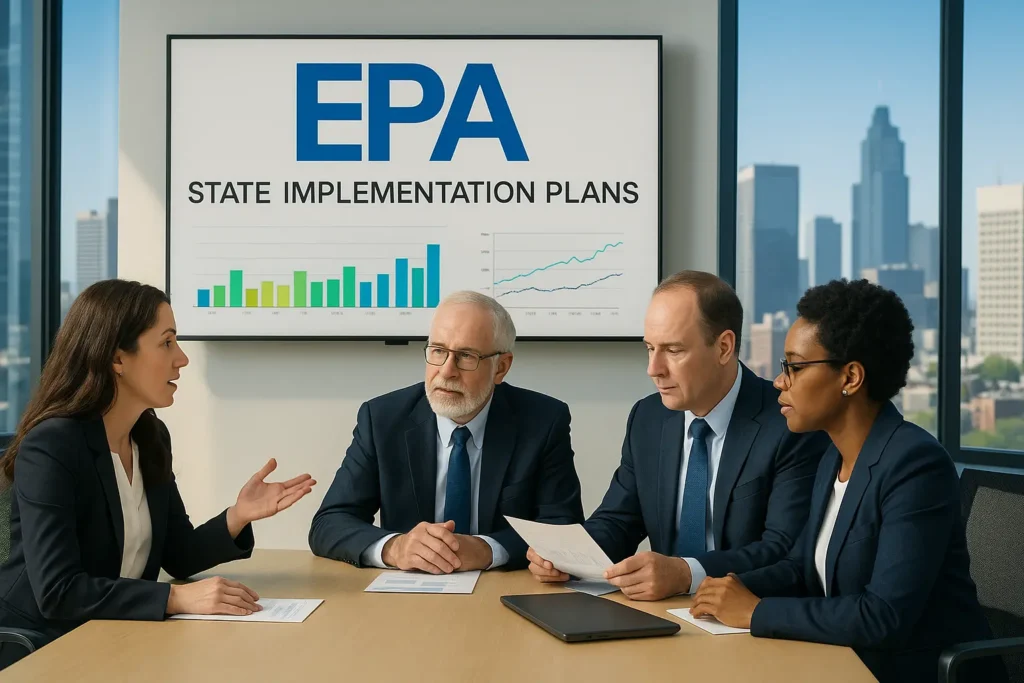Introduction: Air Quality and the US Government’s Role in Protecting Public Health
Air pollution continues to be one of the most pressing environmental concerns in the United States. Poor air quality not only impacts the environment but also poses significant risks to public health. As it can lead to respiratory diseases, cardiovascular problems, and even premature deaths. In response to these challenges, the US Government Is Addressing Air Quality by establishing several key policies to manage air quality, with the Environmental Protection Agency (EPA) at the forefront of these efforts. The EPA plays a critical role in ensuring the air we breathe is safe and clean. Through rigorous regulations, monitoring systems, and public health initiatives.

This blog will explore how the US Government, specifically through the EPA, is addressing air quality issues in the United States. As with the effectiveness of its policies, and the ongoing challenges and advancements in this critical area.
The Clean Air Act: The Backbone of Air Quality Management in the US
The Clean Air Act (CAA) is a landmark piece of legislation passed in 1970. It forms the foundation of the US Government’s efforts to address air pollution. The CAA gives the EPA the authority to regulate air pollutants. And also set National Ambient Air Quality Standards (NAAQS) for the most harmful pollutants. Such as particulate matter, ground-level ozone, sulfur dioxide, carbon monoxide, nitrogen oxides, and lead.
The Clean Air Act is continuously updated to reflect the latest scientific research and technological advancements in air quality management.Under the Clean Air Act, the EPA is responsible for enforcing air quality standards, developing pollution control programs. And also ensuring that states comply with these standards. This legislation has been instrumental in reducing major air pollutants in the US over the past few decades. For example, between 1970 and 2020, total emissions of the six principal air pollutants dropped by more than 70%, despite significant population and economic growth (EPA).
National Ambient Air Quality Standards (NAAQS) and Their Impact on Public Health
One of the EPA’s most important functions under the Clean Air Act is setting and revising National Ambient Air Quality Standards (NAAQS) for the most common air pollutants. NAAQS establish the maximum allowable concentrations of specific pollutants in the air to protect public health. Particularly for vulnerable populations such as children, older people, and people with pre-existing health conditions.
For example, the EPA has recently revised its NAAQS for fine particulate matter (PM2.5) to strengthen protections against air pollution. Research indicates that long-term exposure to PM2.5 causes serious health issues. Including heart disease, lung cancer, and strokes. The EPA has lowered the annual PM2.5 standard from 12.0 micrograms per cubic meter to 9.0 micrograms per cubic meter. To reflect the latest scientific evidence on the health risks of exposure to these tiny particles (EPA).
In addition to PM2.5, other pollutants are regulated by the EPA under NAAQS. It includes ground-level ozone (a key component of smog), nitrogen dioxide, sulfur dioxide, carbon monoxide, and lead. These standards are regularly updated to incorporate the latest scientific findings and improve public health protections.
Regulatory Programs and Initiatives: How the EPA Reduces Air Pollution
The EPA has a wide range of regulatory programs designed to address air pollution across various sectors, from industrial sources to transportation. These programs are essential in achieving the Clean Air Act’s and NAAQS’s objectives.

1. New Source Performance Standards (NSPS)
The EPA’s New Source Performance Standards (NSPS) regulate emissions from new or modified stationary sources of air pollution, such as power plants, refineries, and factories. These standards require new facilities to use the best available pollution control technologies to minimize emissions from the start. By setting stringent requirements for new sources, the EPA helps prevent future increases in air pollution while encouraging industries to adopt cleaner technologies.
2. National Emission Standards for Hazardous Air Pollutants (NESHAP)
In addition to regulating common pollutants, the EPA also sets National Emission Standards for Hazardous Air Pollutants (NESHAP), which target toxic pollutants such as mercury, benzene, and formaldehyde. These pollutants can cause serious health problems, including cancer, neurological damage, and developmental issues. NESHAP focuses on industries that release significant quantities of hazardous pollutants, such as chemical manufacturing and power generation.
3. State Implementation Plans (SIPs)
Under the Clean Air Act, the EPA works closely with state governments. To develop State Implementation Plans (SIPs) that outline how each state will meet and maintain NAAQS. SIPs are tailored to each state’s specific air quality challenges and are subject to EPA approval. This collaborative approach allows for flexibility in addressing local pollution sources while ensuring that states comply with federal air quality standards.
Each year, states submit reports to the EPA detailing their progress in meeting NAAQS. If a state fails to meet these standards, the EPA can take corrective action, such as requiring more stringent regulations or imposing sanctions.
How the US Government Is Addressing Air Quality Challenges?
The landscape of air pollution in the United States is constantly evolving, and the EPA has quickly adapted its policies and regulations to address emerging air quality challenges. Some of the most pressing issues today include the impact of climate change on air quality and pollution from new sources such as wildfires and oil and gas operations.
1. The Impact of Climate Change on Air Quality
Climate change and air quality are closely linked. Rising temperatures can increase the formation of ground-level ozone, a major component of smog, which is harmful to human health. Additionally, climate change is expected to cause more frequent and intense extreme weather events, such as wildfires, which can worsen air pollution levels.
The EPA has developed strategies to monitor and mitigate the impact of climate change on air quality. These strategies include promoting the use of clean energy sources, supporting the development of low-emission transportation technologies, and strengthening air quality standards for pollutants such as ozone and particulate matter. By addressing both air quality and climate change together, the EPA aims to improve the health of both the environment and the population.
2. Pollution from Wildfires
Wildfires have become a major source of air pollution in the United States, particularly in the western states. The EPA has taken steps to monitor wildfire smoke and provide public health guidance for affected areas. Wildfire smoke contains fine particulate matter (PM2.5), which can travel long distances and affect communities far from the fire’s origin. The EPA works with state and local governments to issue air quality advisories, set up monitoring systems, and provide resources for people who are vulnerable to smoke exposure, such as children, the older people, and people with respiratory conditions.
3. Air Pollution from Oil and Gas Operations
Oil and gas operations are a significant source of air pollution in many parts of the United States. The EPA has implemented regulations to reduce methane emissions, volatile organic compounds (VOCs), and other pollutants from these operations. For example, the EPA’s 2016 rule to reduce methane emissions from new and modified oil and gas facilities has been an important step in addressing pollution from this sector EPA.
Challenges and Future Directions for EPA Air Quality Policies
Although the US has made significant progress in improving air quality, challenges remain. One of the biggest challenges is effectively enforcing air quality standards across all regions, especially in areas with high levels of industrial pollution. Additionally, economic and political factors can sometimes hinder the implementation of stricter air quality regulations.
To address these challenges, the EPA is focused on several key areas moving forward:
- Incorporating Advanced Technologies: The EPA is investing in new technologies, such as air pollution sensors and satellite monitoring, to improve its ability to track and predict air quality. This will enable faster responses to emerging air quality threats, such as wildfire smoke or industrial accidents.
- Promoting Environmental Justice: The EPA is placing greater emphasis on environmental justice by ensuring that vulnerable communities, including low-income and minority populations, have equal protection from air pollution. These communities often bear a disproportionate burden of pollution, which the EPA aims to address through targeted policies and initiatives.
- Strengthening Air Quality Standards: The EPA will continue to update air quality standards based on the latest scientific research to ensure they provide the best possible protection for public health. This includes revising standards for pollutants like ozone and particulate matter to reflect the latest health data.
Conclusion: The Role of the US Government in Securing Clean Air for Future Generations
The US Government and the EPA work is addressing Air Quality and ensuring that the air we breathe is safe. Through the Clean Air Act, National Ambient Air Quality Standards, and other regulatory programs, the US Government has made significant strides in improving air quality across the nation. However, challenges such as climate change, wildfire pollution, and the rise of new industrial sources of pollution require ongoing attention and innovation.
As the EPA continues to strengthen air quality standards, embrace new technologies, and focus on environmental justice, the United States is taking important steps toward cleaner air and a healthier future for all. By working with state and local governments, industries, and communities, the US Government can ensure that future generations enjoy clean, healthy air.
Will the EPA Roll Back Air Pollution Regulations—and at What Cost?
Note: All the images used in this blog are AI-generated.







